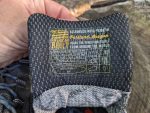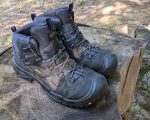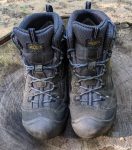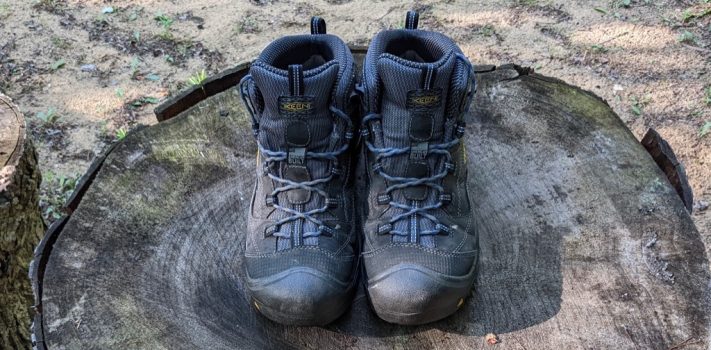I recently bought a pair of Keen American Built Boots at a consignment store. They cost me $44.99. These Braddock Waterproof Mid Soft Toe Boots run $220 per pair, new. The Keen Braddock mid-cut boots are very sturdy, though the soles are somewhat stiffer than I prefer. They are also extremely warm, making them most suitable for cool weather use.
All in all, they are decent boots, and American-made. But they somehow lack that measure of comfort that gives a pair of boots a place of affection in my heart. It may just be that my feet are a funny shape, but I cannot recommend these boots.
The Backstory
My wife, “Kari”, and I were on a camping trip with our daughter, son-in-law, and three grandchildren. On one of the days of our trip, we made a quick detour back to civilization. We believed that a nearby town hosted a branch of one of our favorite thrift stores, and we wanted to check it out. Alas, our hopes were dashed. It was just a donation center for the chain, and not a retail outlet.
While we were in town, we ran across a consignment store. We stopped in to check things out. There I found a pair of work boots in my size. The inside of the tongue stated, “Assembled with Pride in Portland, Oregon Using the Finest Materials from Around the World.” That sounded interesting, so I decided to try them on. They seemed to fit okay, so I paid the asking price of $44.99. As soon as we got back to the car, I put on my new pair of boots.
First Impressions
 As I began wearing the boots, I gained a growing conviction that the soles were just a little too stiff. They have a stability shank that would help make the boots more comfortable for tasks like standing on an o-rung ladder for long periods of time, or hiking across rocky ground. But to me, the shank is stiff enough that it makes the boots feel a bit clumsy, almost like a pair of wooden shoes. It brought my mind back to my high school English literature class, as we studied a portion from Gerard Manley Hopkins’ poem, “God’s Grandeur”:
As I began wearing the boots, I gained a growing conviction that the soles were just a little too stiff. They have a stability shank that would help make the boots more comfortable for tasks like standing on an o-rung ladder for long periods of time, or hiking across rocky ground. But to me, the shank is stiff enough that it makes the boots feel a bit clumsy, almost like a pair of wooden shoes. It brought my mind back to my high school English literature class, as we studied a portion from Gerard Manley Hopkins’ poem, “God’s Grandeur”:
Generations have trod, have trod, have trod;
And all is seared with trade; bleared, smeared with toil;
And wears man’s smudge and shares man’s smell: the soil
Is bare now, nor can foot feel, being shod.
This stiffer sole would probably make it advisable to allow a longer than average break-in period prior to wearing the boots for extended field use.
The boots are also extremely warm. On cold mornings and cool evenings it felt good to have toasty-warm feet. In the heat of the day, the boots could become uncomfortably hot.
 The boots are advertised as waterproof, and they stand up to the test. With my grandchildren playing on shore, I stood in a lake in ankle deep water for an extended period of time to test the boots. My feet remained bone dry. Indeed, throughout the testing period my feet were more likely to get wet from sweat than from leakage. The boots seem to run about half a size small. Fortunately, the pair I bought was about half a size larger than I normally buy, so they fit quite well.
The boots are advertised as waterproof, and they stand up to the test. With my grandchildren playing on shore, I stood in a lake in ankle deep water for an extended period of time to test the boots. My feet remained bone dry. Indeed, throughout the testing period my feet were more likely to get wet from sweat than from leakage. The boots seem to run about half a size small. Fortunately, the pair I bought was about half a size larger than I normally buy, so they fit quite well.
I have not yet had the opportunity to test the boots for traction on ice and snow. If any SurvivalBlog readers own a pair of Keen Braddock Boots and can enlighten us on their performance in wintery conditions, I would invite them to submit their observations to the weekly “Snippets” column.
The Keen American Built Collection
Keen currently offers 23 styles in men’s and women’s boots that are made in the USA. Most are work boots with steel, carbon-fiber, or soft toes. A few are designed to be hiking boots.
The Braddock line that I purchased is a hiker-inspired work shoe that is available as either low or mid-cut. It is available in two color schemes (Cascade Brown/Tawny Olive or Raven/Estate Blue). It uses a KEEN.DRY membrane to make the boot waterproof and breathable. The stability shank that I referred to above is made of TPU (Thermoplastic Polyurethane).
Boots, Fording Rivers, and Leprosy
One summer about the time that I graduated from high school, my family and I were part of a medical missions team to an island in the Carribean Sea.
One day, we were scheduled to visit a leper colony. We were to make our way along a stretch of beach, ford the mouth of a “knee-deep” river, and then come out into the colony. Unbeknownst to us, recent heavy rain in the mountains had made the river unusually swift and deep.
I arrived at the river along with a number of the faster and more gung-ho members of the team. We all began taking off our boots and socks and rolling our pant legs above the knee in preparation for fording the river.
A young lady of about 12 years of age was the first to attempt the crossing. She was quickly swept off her feet by the powerful current. She managed to grab hold of a rock in the middle of the river, and was stranded there.
What young man can resist the opportunity to go to the aid of a damsel in distress. I boldly waded out into the river to rescue the young lady. A number of data points quickly came to my attention.
First of all, the water flowing from the mountains was much colder than I expected from a tropical river.
Second, the bottom of the river was much more rocky than I expected after walking on the smooth sand of the beach. I forgot that the river current would sweep any sand away, leaving just rocks behind.
Third the river was much deeper and swifter than I had anticipated.
I managed to make it safely to the rock to which the young lady clung. I began to assist her back toward the bank of the river.
When we were about halfway back, one of us took a misstep. We both lost our balance, and began to be pushed downstream by the swiftly flowing current. We tried to regain our footing, but it was a losing battle. In desperation, I shoved the young lady toward the shore. Waiting hands grabbed her and pulled her to safety.
For every action there is an equal and opposite reaction. Pushing the young lady toward shore thrust me deeper into the current. It soon became clear that resistance was futile. I was assimilated fully into the current, and was swept swiftly downstream, out of the mouth of the river, and into the Caribbean Sea.
I attempted to regain my footing as I entered the sea. The rocks there were covered in barnacles. My feet were badly cut by the sharp edges of their shells. I continued to be swept along, now with bleeding feet, out into what we had been told was shark infested water.
By swimming perpendicularly to the direction of the current, I was able to escape the cold waters of the river and enter the blood-warm water of the Caribbean. When I was free of the current, I was able to swim to the beach on the far side of the river. I limped ashore into the leper colony with bare and bleeding feet.
Subsequent reading informed me that mycobacterium leprae and mycobacterium lepromatosis, (the bacteria which cause Hanson’s Disease/leprosy) can have an incubation period of up to 20 years. Periodically for the next 20 years or so, I wondered if I would wake up the next day with symptoms of leprosy.
All of this has influenced my opinion of whether or not one should wear boots while fording rivers.
Fording a river has been appropriately compared to climbing a rocky mountain, blindfolded, and in the rain. It is not the type of thing one should do while barefoot.
Assuming that a river is suitable for fording, one option is to wear a pair of sturdy footwear designed for use in the water. For example, I have an excellent pair of Olukai ‘Imaka trainers that would provide good foot protection while fording rivers.
If no dedicated footwear is available, I recommend removing socks, putting boots back on, fording the river, drying boots and feet thoroughly, putting on socks and boots, and resuming the journey. (By the way, unbuckle the hip belt and loosen the straps on your pack before fording a river. You don’t want the pack to hold your head underwater if you fall).
Wearing boots while fording a river is not without its drawbacks. It is difficult to get wet boots thoroughly dry. Wet boots and socks can cause blisters. Blisters can be crippling and even life-threatening under field conditions. But lacerated feet or being swept down a river can be at least equally crippling or life threatening. Take these factors into account as you plan your river crossings.
Conclusions
 Keen Braddock Mid-cut Boots are sturdy, warm, waterproof, American-made boots. Unfortunately, I found them to be excessively stiff, so that they failed the comfort test. I am disappointed that I cannot recommend them. Preferred footwear is a matter of deeply personal and highly subjective opinion. Some SurvivalBlog readers may have dramatically different thoughts about Keen Braddock Mid-cut Boots. If so, I invite their comments in the weekly “Snippets” column.
Keen Braddock Mid-cut Boots are sturdy, warm, waterproof, American-made boots. Unfortunately, I found them to be excessively stiff, so that they failed the comfort test. I am disappointed that I cannot recommend them. Preferred footwear is a matter of deeply personal and highly subjective opinion. Some SurvivalBlog readers may have dramatically different thoughts about Keen Braddock Mid-cut Boots. If so, I invite their comments in the weekly “Snippets” column.
Disclaimer
I did not receive any financial or other inducement to mention any vendor, product, or service in this article.










